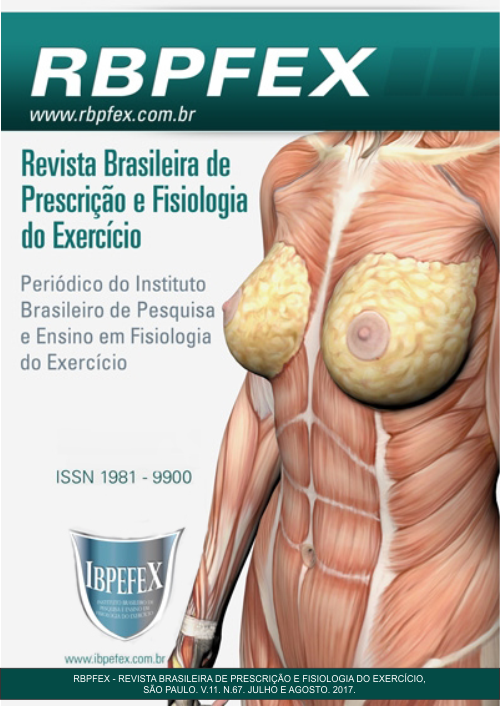Immunodulation in experimental model of rheumatoidarthritis submitted to the treatment of paladio omplex and swimming
Abstract
Rheumatoid arthritis (RA) is an autoimmune disorder that leads to joint inflammation affecting bone and cartilage tissues. Metal complexes, including the palladium, have been used in medicine as an alternative for treatment of various diseases. Assess activity of palladium and immune response in experimental models. Cytokines from the immunological system were analyzed and quantified regarding the action of the metal complex palladium associated with swimming practice in arthritic experimental models after 30 days from the induction of RA. 56 male Wistar rats were divided into 14 groups: i. arthritic, that received the RA induction by antigen Mycobacterium sp together with the CFA; and ii. control, submitted or not to swimming three times a week in 30-minute sessions. It is observed that the arthritic groups treated with palladium (G1 and G4) had increased levels of anti-inflammatory cytokine TGF-β. G1 obtained a reduction of pro-inflammatory cytokine IL-4 compared to their control group (G7) due to swimming. Other cytokines (TNF-α and IL1-β), on groups G1 and G4, when compared to the arthritic groups not treated with palladium (G2, G3, G5 and G6), didn't have their levels reduced below their control groups (G7 and G10); however, they responded well to the reduction of TNF-α and IL-1-β comparing arthritic and control groups both not treated with palladium. Therefore, the palladium complex, associated with swimming practice, is a proposition for therapeutic intervention for the rehabilitation of rheumatoid arthritis experimental models.
References
-Abbas, A. K.; Lichtman, A. H.; Pillai, S. P. Cellular and Molecular Immunology. Elsevier Science. 8ª edição 2015.
-Ambrose, M.; e colaboradores. Doenças: da sintomatologia ao plano de alta. Rio de Janeiro: Guanabara Koogan. Vol. 1. 2007.
-Bakhtiar, R.; Ochiai, E. Pharmacological applications of inorganic complexes. General Pharmacology. Huntington. p. 525-540. 1999.
-Caromano, F.; Ide, M. Movimento na Água. Fisioterapia Brasil. Vol. 4. Núm. 2. 2003.
-Chiarello, B.; e colaboradores. Fisioterapia reumatológica. Barueri. Manole. 2005.
-Corbacho, M. I.; Dapueto, J. J. Avaliação da capacidade funcional e da qualidade de vida em paciente com artrite reumatoide. Revista Brasileira de Reumatologia. Vol. 50. Núm. 1. p. 31-43. 2010.
-Dellalibera-Joviliano, R.; Reis, M. L.; Cunha, F. Q.; Donadi, E. A. Kinins and cytokines in plasma and cerebrospinalfluid of patients with neuropsychiatric lupus. The Jounal of Rheumatology. Vol. 30. Núm. 3. 2003.
-Duarte, M. Princípios físicos da interação entre ser humano e ambiente aquático. São Paulo. 2004.
-Garoufis, A.; Hadjikakou, S. K.; Hadjiliadis, N. Palladium Coordination Compounds as Anti-Viral, Anti-fungal, Anti-microbial and Anti-tumor Agents. Coord. Chem. Rev. Vol. 253. p. 138-1397. 2009.
-Houglum, P. A. Exercícios terapêuticos para lesões musculoesqueléticas 3ª edição. Manole. 2015.
-Louzada-Junior, P.; Souza, B. D. B.; Toledo, R. A.; Ciconelli, R. M. Análise descritiva das características demográficas e clínicas de pacientes com artrite reumatoide do estado de São Paulo, Brasil. Revista Brasileira de Reumatologia. Vol. 47. Núm. 2. p. 84-90. 2007.
-Medeiros, A.; Gianolla, R. M.; Kalil, L. M. P.; Bacurau, R. F. P.; Rosa, L. F. B. C.; Negrão, C. E.; Brum, P. C. Efeito do treinamento físico com natação sobre o sistema cardiovascular de ratos normotensos. Rev. paul. Educ. Fís. Vol. 14. Núm. 1. p.7-15. 2000.
-Mota, E. F.; Lima, M. G. S.; Melo, D. F. Adjuvantes imunológicos: avanços e perspectivas. Ciência Animal. Vol. 16. Núm. 2. p. 79-88. 2006.
-Nunes, M. V. O.; Câmara, C. P.; Crespo, A. M. C.; Carvalhaes, M.; Oliveira, C. R.; Silveira, L. A. Comparação do perfil de anticorpos antiimunoglobulina G em murinos imunizados com igg humana associada a diferentes adjuvantes. Revista Eletrônica de Farmácia. Vol. 6. Núm. 1. p. 44-50. 2009.
-Resende, F. C. B.; Passold, J.; Ferreira, S. I. A. C.; Zanetti, C. R.; Lima, H. C. Adjuvantes de vacinas: possibilidades de uso em seres humanos ou animais. Rev. bras. alerg. Imunopatol. Vol. 27. Núm. 3. p. 116-124. 2004.
-Rubin, E. Patologia. 3ªedição. Rio de Janeiro. Guanabara Koogan. 2002.
-Saijo, S.; Asano, M.; Horai, R.; Yamamoto, H.; Iwakura, Y. Supression of autoimune arthritis in impaired due to low levels of CD40 ligand and OX40 expression on T cells. Arthritis & Rheumatism. Vol. 46. p. 533-544. 2002.
-Volpato, G. T.; Damasceno, D. C.; Campos, K. E.; Rocha, R.; Rudge, M. V. C.; Calderon, I. M. P. Avaliação do efeito do exercício físico no metabolismo de ratas diabéticas prenhes. Rev Bras Med Esporte. Vol. 12. Núm. 5. p. 229-233. 2006.
-Zambon, L.; Duarte, F. O.; Freitas, L. F.; Scarmagnani, F. R. R.; Dâmaso, A.; Duarte, A. C. G. O; Sene-Fiorese, M. Efeitos de dois tipos de treinamento de natação sobre a adiposidade e o perfil lipídico de ratos obesos exógenos. Rev. Nutr. Vol. 22. Núm. 5. p. 707-715. 2009.
Authors who publish in this journal agree to the following terms:
- Authors retain the copyright and grant the journal the right of first publication, with work simultaneously licensed under the Creative Commons Attribution License BY-NC which allows the sharing of the work with acknowledgment of the authorship of the work and initial publication in this journal.
- Authors are authorized to enter into additional contracts separately for non-exclusive distribution of the version of the work published in this journal (eg, publishing in institutional repository or book chapter), with acknowledgment of authorship and initial publication in this journal.
- Authors are allowed and encouraged to post and distribute their work online (eg, in institutional repositories or on their personal page) at any point before or during the editorial process, as this can bring about productive change as well as increase impact and impact. citation of published work (See The Effect of Free Access).






